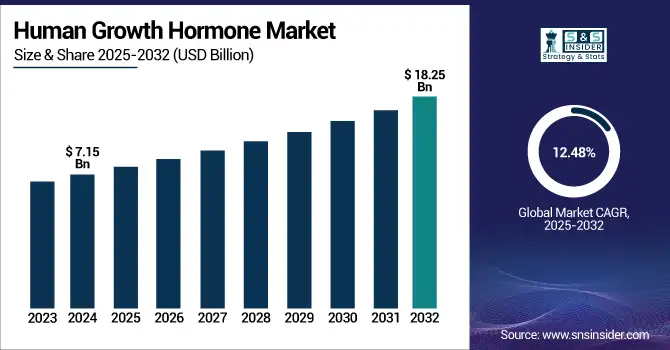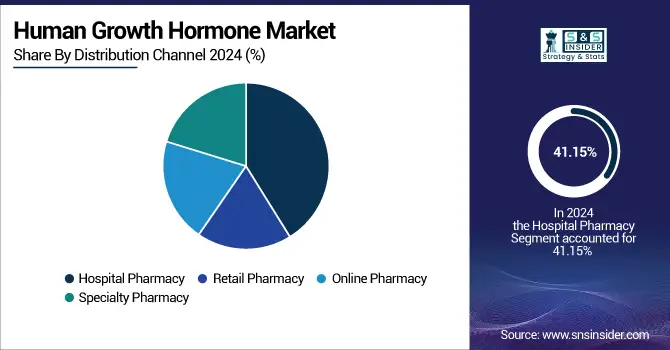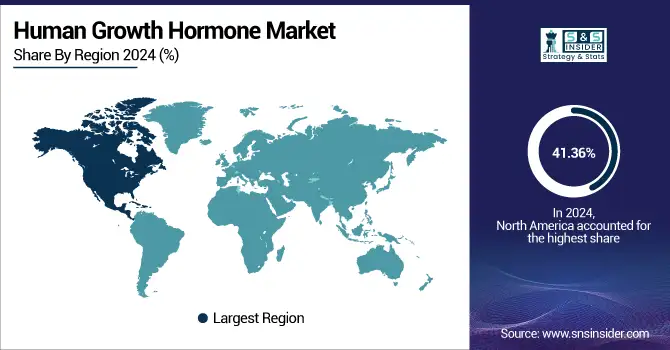Human Growth Hormone Market Size Analysis:
The Human growth Hormone Market size was valued at USD 7.15 billion in 2024 and is expected to reach USD 18.25 billion by 2032, growing at a CAGR of 12.48% over the forecast period of 2025-2032.

To Get more information on Human growth Hormone Market - Request Free Sample Report
The Human Growth Hormone (HGH) Market is witnessing consistent growth based on increasing incidences of growth hormone deficiency, heightened awareness regarding hormone deficiency disorders, and improved recombinant DNA technology. The market is also supported by the increasing popularity of long-acting HGH formulations and the expanding applications of HGH treatments in pediatric and adult patients. In addition, regulatory clearances, positive reimbursement policies, and the growth of biosimilar HGH products are driving market growth in both developed and emerging healthcare systems.
U.S. human growth hormone market size was valued at USD 2.58 billion in 2024 and is expected to reach USD 6.38 billion by 2032, growing at a CAGR of 12.02% over the forecast period of 2025-2032.
The U.S. dominated the North American human growth hormone (HGH) market because of its sophisticated healthcare infrastructure, high incidence of growth hormone deficiencies, and prevalent adoption of recombinant and long-acting HGH treatments.
Growth hormone deficiency is relatively rare. About one in 4,000 to 6,000 children has GHD, and it affects about 50,000 U.S. adults. Supportive reimbursement policies, strong research and development efforts, and the presence of major pharma players further support the U.S.'s dominant position in the region.
Human Growth Hormone Market Dynamics
Drivers
-
Increasing Prevalence of Growth Hormone Deficiencies is Driving the Growth Hormone Market Trends
One of the key factors driving the Human Growth Hormone (HGH) market is the growing incidence of growth hormone deficiencies, especially among pediatric and adult populations. Growth hormone deficiency can be caused by several conditions, such as genetic disorders (e.g., Turner Syndrome, Prader-Willi Syndrome), trauma, tumors, or idiopathic reasons.
The increasing diagnosis of growth hormone deficiencies directly heightens the demand for HGH treatments. Pediatric growth hormone deficiency (GHD) typically develops in children who do not develop at the typical rate, and adult GHD can be a function of age or early-life deficiencies. More individuals seek out HGH treatments as recognition of these diseases continues to expand and diagnostic testing evolves.
-
As per the World Health Organization (WHO), it is estimated that 1 in 4,000 to 1 in 10,000 children suffer from growth hormone deficiency (GHD).
-
One study published in the European Journal of Endocrinology identified that about 1 in 10,000 children globally are born with growth hormone deficiencies. This has raised the number of children undergoing HGH treatment all over the world.
-
Rising Awareness and Early Diagnosis to drive the Human Growth Hormone Market Growth
Increased realization regarding growth hormone deficiencies and enhanced diagnostic possibilities is an important factor responsible for the global human growth hormone market growth. With more medical professionals, patients, and society as a whole becoming increasingly educated about diseases such as growth hormone deficiency, disorders like Turner Syndrome, and idiopathic short stature, the pool of people searching for treatment has increased.
For instance, in the U.S. and certain European nations, educational initiatives and public information campaigns regarding disorders of growth have been important factors in ensuring parents and physicians notice the indicators of growth hormone deficiencies early. With Turner Syndrome, early detection means that treatment with HGH can be implemented early, which facilitates more typical patterns of growth.
According to NCBI, Turner syndrome occurs in approximately 1 in 2000 to 1 in 2500 live female births. Nonetheless, the actual prevalence remains unknown because numerous patients with a mild phenotype might not be diagnosed or are diagnosed late in adulthood.
The ability to identify these conditions at an early stage, owing to awareness, has resulted in a greater rate of treatment and diagnosis, subsequently increasing the demand for HGH therapies. Early treatment maximizes long-term results, and this has widened the general consumption of HGH products within clinics.
Restraint
-
One Major Limitation in the Human Growth Hormone Market is the Expensive HGH Therapies
The cost of long-term HGH treatment can be staggering, especially for those who are from low-income areas or lack proper insurance coverage. These steep costs might deter access to treatment among a large number of patients, particularly in developing nations where healthcare facilities and reimbursement systems are less sophisticated, possibly impeding market expansion.
Human Growth Hormone Market Segmentation Analysis
By Product
In 2024, the other segment dominated the human growth hormone market share with 96.32% as a result of the extensive availability of traditional daily HGH products, including somatropin, which have been well-established as the conventional treatment for growth hormone deficiency. These drugs are well-trusted by healthcare professionals and are commonly prescribed as a result of their clinical effectiveness and established safety profiles. Also, higher approvals and commercial availability of these conventional products from different manufacturers helped to make them widely used and market leaders in the base year.
The long-acting segment is anticipated to witness the fastest growth in human growth hormone market share over the forecast period due to increasing demand for more convenient, once-weekly treatment regimens. These products reduce the inconvenience of daily injections, improving patient compliance, especially in children. Advances in drug delivery technologies and recent US FDA approvals of long-acting agents such as somapacitan-beco and somatrogon-ghla are driving adoption.
By Application
In 2024, the Growth Hormone (GH) Deficiency segment held the largest market share in human growth hormone with 42.16% because of its widespread prevalence among both pediatrics and adults. The condition is an indicator of the top clinical preference for HGH treatment, promoting considerable demand. Early diagnosis, especially among growth retardation cases in children, and wide-scale implementation of recombinant HGH products also helped maintain segment leadership. The segment has strong clinical guidelines and insurance coverage, which enhance treatment accessibility and allow its a leadership position in the market.
The Pediatric GH Deficiency segment is anticipated to have the fastest growth in the forecast years, spurred by increasing awareness regarding early growth disorders and increased screening activities at pediatric clinics and schools. Advances in treatment, such as long-acting formulations of growth hormone, are enabling greater compliance with therapy among children.
By Distribution Channel
The hospital pharmacy segment dominated the human growth hormone market in 2024 because hormone therapy management is centralized, and dispensing in a clinical environment with close monitoring is preferred. Hospitals generally deal with complicated endocrine disorders and children's cases and are, therefore, an initial point of distribution for HGH prescriptions. Hospital pharmacies also provide tight regulation of dosage and storage, providing greater safety and treatment efficacy. Their convenience to coordinate with experts also fuels demand for HGH distribution through this medium.
The online pharmacy segment is anticipated to experience the fastest growth in the forecast years with 13.44% CAGR, fueled by the growing trend toward digital medicine and convenience in drug procurement. Chronic patients, such as those with HGH deficiency, are turning toward home-based treatment and digital prescription dispensing. Web platforms provide competitive prices, discreet shipping, and auto-refill features, which are attractive to a wider patient base. Regulatory innovation favoring e-pharmacy models and enhanced cold-chain logistics further enables the swift expansion of this segment.

Human Growth Hormone Market Regional Analysis
North America led with the highest human growth hormone market share of about 41.36% in 2024, owing to its established healthcare system, high level of awareness regarding growth hormone disorder, and presence of major pharmaceutical companies. The region is aided by superior diagnostic equipment and a high level of early detection and treatment of endocrine disorders. Reimbursed policies favorable to growth, along with regulatory approvals for new therapies like long-acting HGH formulations, also augment the growth of the market. The U.S., in general, has extensive applications of recombinant HGH treatments and high investments in clinical R&D.
Asia Pacific is anticipated to witness the fastest growth in the HGH market share, with 12.97% CAGR due to increased spending on healthcare, improved awareness of hormone deficiency, and enhanced access to healthcare centers. These countries, such as China, India, and Japan, are witnessing rising demand for pediatric and adult hormone therapy due to rising populations and increased prevalence of growth-related disorders. In addition, government backing of healthcare modernization and the accessibility of biosimilar HGH products are also pushing market penetration. The growing adoption of digital health solutions and telemedicine further propels broader access to HGH therapy in the region.
Germany dominated the European human growth hormone market because of the country's state-of-the-art healthcare system, well-developed pharmaceutical sector, and a high degree of growth hormone disorder diagnosis and treatment. There is a developed network of pediatricians and endocrinologists operating in the nation, guaranteeing early detection as well as treatment of HGH deficiency.
Latin America is witnessing moderate growth in the human growth hormone market, fuelled by growing awareness of disorders related to growth and increasing healthcare infrastructure. Brazil and Mexico are leading countries due to growing healthcare spending and growing access to hormone therapy. There are still challenges, such as restricted reimbursement policies and disparities in access to specialist care, that affect the overall growth pattern.
In the Middle East and Africa (MEA), the market is recording consistent forward momentum, driven by improvements in healthcare infrastructure and increasing investment in medical facilities. South Africa and the UAE are leading this expansion through government-driven healthcare programs and increased diagnosis levels. However, limited access and awareness of specialized hormone therapy in parts of the region continue to pose challenges to more rapid growth.

Get Customized Report as per Your Business Requirement - Enquiry Now
Human Growth Hormone Market Key Players
Novo Nordisk A/S, Pfizer Inc., Eli Lilly and Company, Merck KGaA, Genentech, Inc. (Roche), Ferring Pharmaceuticals, Teva Pharmaceutical Industries Ltd., Sandoz International GmbH (Novartis AG), Ipsen S.A., Anhui Anke Biotechnology (Group) Co., Ltd., and other players.
Recent Developments in the Human Growth Hormone Market
-
April 2023 –Novo Nordisk announced that the U.S. Food and Drug Administration (FDA) approved a new indication for Sogroya (somapacitan-beco) injection, 5 mg, 10 mg, and 15 mg dosages, for the treatment of children 2.5 years of age or older who have growth failure as a result of inadequate secretion of endogenous growth hormone. The approval makes Sogroya the first and only once-weekly growth hormone (GH) therapy available for both children and adults.
-
June 2023 – OPKO Health Inc. and Pfizer Inc. have announced that the U.S. Food and Drug Administration (FDA) has approved NGENLA (somatrogon-ghla), an analog of human growth hormone administered once weekly. NGENLA is approved to treat pediatric patients aged three years and older with growth failure due to deficient secretion of endogenous growth hormone.
| Report Attributes | Details |
|---|---|
| Market Size in 2024 | USD 7.15 Billion |
| Market Size by 2032 | USD 18.25 Billion |
| CAGR | CAGR of 12.48% From 2025 to 2032 |
| Base Year | 2024 |
| Forecast Period | 2025-2032 |
| Historical Data | 2021-2023 |
| Report Scope & Coverage | Market Size, Segments Analysis, Competitive Landscape, Regional Analysis, DROC & SWOT Analysis, Forecast Outlook |
| Key Segments | •By Product (Long Acting, Others) •By Application (Growth Hormone (GH) Deficiency, Adult GH Deficiency, Pediatric GH Deficiency, Turner Syndrome, Idiopathic Short Stature, Prader-Willi Syndrome, Small for Gestational Age, Other) •By Distribution Channel (Hospital Pharmacy, Retail Pharmacy, Online Pharmacy, Specialty Pharmacy) |
| Regional Analysis/Coverage | North America (US, Canada, Mexico), Europe (Germany, France, UK, Italy, Spain, Poland, Turkey, Rest of Europe), Asia Pacific (China, India, Japan, South Korea, Singapore, Australia, Rest of Asia Pacific), Middle East & Africa (UAE, Saudi Arabia, Qatar, South Africa, Rest of Middle East & Africa), Latin America (Brazil, Argentina, Rest of Latin America) |
| Company Profiles | Thermo Fisher Scientific, Agilent Technologies, Shimadzu Corporation, Novo Nordisk A/S, Pfizer Inc., Eli Lilly and Company, Merck KGaA, Genentech, Inc. (Roche), Ferring Pharmaceuticals, Teva Pharmaceutical Industries Ltd., Sandoz International GmbH (Novartis AG), Ipsen S.A., Anhui Anke Biotechnology (Group) Co., Ltd., and other players. |

